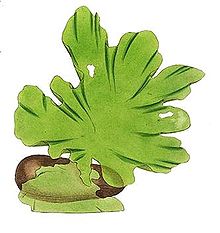Ulva lactuca
| Ulva lactuca | |
|---|---|

| |
| Ulva lactuca in Brofjorden, Sweden | |

| |
| Illustration of Ulva lactuca in English Botany (Sowerby, 1790-1814) | |
| Scientific classification | |
| (unranked): | Viridiplantae |
| Division: | Chlorophyta |
| Class: | Ulvophyceae |
| Order: | Ulvales |
| Family: | Ulvaceae |
| Genus: | Ulva |
| Species: | U. lactuca
|
| Binomial name | |
| Ulva lactuca | |
Ulva lactuca, also known by the common name
Description
Ulva lactuca is a thin flat green alga growing from a discoid holdfast. The margin is somewhat ruffled and often torn. It may reach 18 centimetres (7.1 in) or more in length, though generally much less, and up to 30 centimetres (12 in) across.[3] The membrane is two cells thick, soft and translucent, and grows attached, without a stipe, to rocks or other algae by a small disc-shaped holdfast.[4]
Green to dark green in colour, this species in the Chlorophyta is formed of two layers of cells irregularly arranged, as seen in cross-section. The chloroplast is cup-shaped in some references but as a parietal plate in others[4] with one to three pyrenoids. There are other species of Ulva which are similar and not always easy to differentiate.
Distribution
The distribution is worldwide: Europe, North America (west and east coasts), Central America, Caribbean Islands, South America, Africa, Indian Ocean Islands, South-west Asia, China, Pacific Islands, Australia and New Zealand.[4][5]
Ecology
Ulva lactuca is very common on rocks and on other algae in the
Certain environmental conditions can lead to the algae spreading over large areas. In August 2009, unprecedented levels of the algae washed up on the beaches of
Life history
The sporangial and gametangial thalli are morphologically alike. The
Uses
U. lactuca is locally used in Scotland in soups and salads.[21] [22] In Hawaiʻi, U. lactuca is also called limu pālahala and eaten in different ways: mixed with other algae, salted and served with raw fish, boiled in water and served as a soup, or served with chili pepper, onions, soy sauce and sugar.[23] Additionally, U. lactuca has traditional uses in Hawaiʻi as fertilizer and as adornment for hula.[23] When U. lactuca is used for hula it is called limu pāpahapaha.[23]
References
- ISBN 9780906720561.
- ^ Bates, Colin. "An introduction to the (macro) algae of British Columbia". Electronic Atlas of the Flora of British Columbia, University of British Columbia. Retrieved 29 July 2020.
- ^ "Ulva lactuca". Gettysburg College. Retrieved December 28, 2007.
- ^ ISBN 978-0-565-00981-6.
- ^ "Ulva lactuca Linnaeus". AlgaeBase.
- ISBN 978-3-906166-35-3.
- ^ a b "Tisbe taxon details: Ulva lactuca Linnaeus, 1753". Flanders Marine Institute (VLIZ).
- .
- ^ Michael Guiry. "Overview of Ulva lactuca ecology". The Seaweed Site. Retrieved December 28, 2007.
- ^ a b Hirst, Michael (August 11, 2009). "Toxic seaweed clogs French coast". BBC News. Retrieved August 11, 2009.
- ^ a b "Seaweed suspected in French death". BBC News. September 7, 2009. Retrieved 2009-09-08.
- .
- ^ a b Hirst, Michael (2009-08-11). "Toxic seaweed clogs French coast". BBC. Retrieved 2009-08-11.
- Telegraph.co.uk. Retrieved 2009-08-11.
- ISBN 9781408846421.
- ^ Chrisafis, Angelique. "Brittany beaches hit by toxic algae". The Guardian. No. 27 July 2011. Retrieved 31 December 2015.
- ^ McKenna, Maryn (26 July 2011). "Attack of the Deadly Slime: Farm Effluent Ruins French Beaches". Wired. Retrieved 31 December 2015.
- ISBN 978-0-8047-0867-8.
- ISBN 978-0-930118-29-7.
- ^ ""Plant Science 4 U". Retrieved 5 July 2016.
- ISBN 0 471 92947 6
- ^ "Ulva Recipes". Monterey Bay Aquarium Research Institute. Archived from the original on January 2, 2008. Retrieved December 28, 2007.
- ^ )
Further reading
- Hayden, H.S., Blomster, J., Maggs, C.A., Silva, P.C., Stanhope, M.J. and Waaland, J.R. (2003) "Linnaeus was right all along: Ulva and Enteromorpha are not distinct genera" European Journal of Phycology 38: pp. 277–294,
